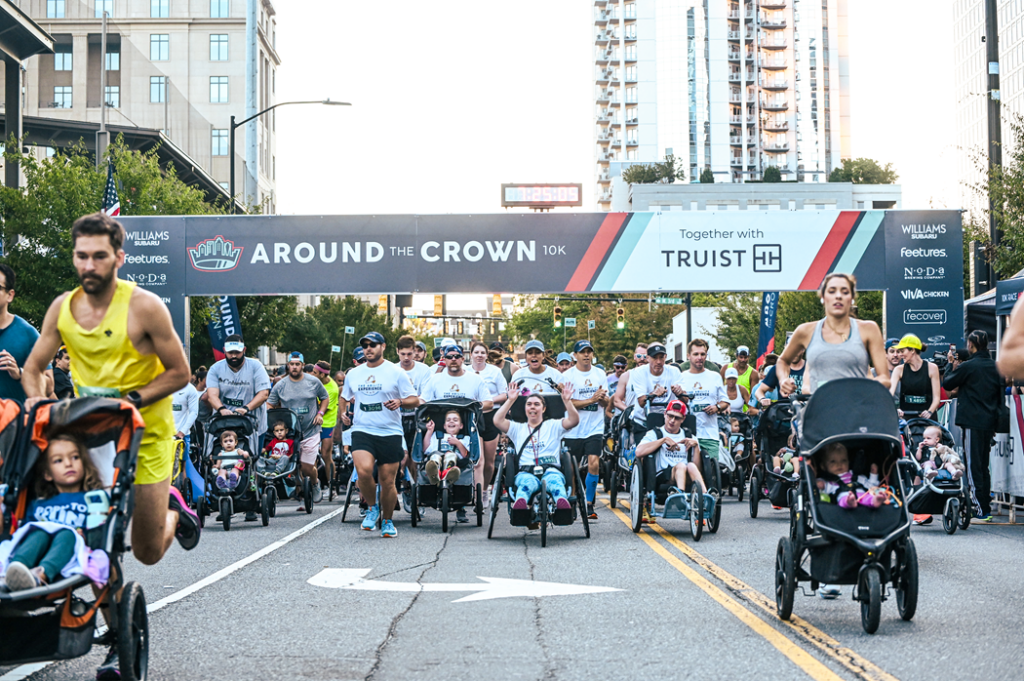When should you start postpartum training?
We are big believers of having kids AND goals, so we want to see you at the starting line of Around the Crown 10K Together with Truist! With the help of S.L.A.M., we’re going to get you there full of confidence with your newest bundle of joy.
As you start mapping out your calendar, remember that this is a general guideline for the next couple of months. There is no exact timeline as everyone’s delivery, healing, and postpartum journey differs. We highly recommend visiting a Pelvic Floor Physical Therapist for an individualized plan and personalized guidance.
Step 1: Ready, set, REST!
Congrats on your new stroller buddy! If you are still newly postpartum (0-8 weeks), this is the time when the most important thing you can do is REST! Sleep (when you can) and let yourself recover and adjust to your new schedule.
Step 2: Movement
As you and your body start to feel ready, this may be around the 2-6 week mark, you can introduce intentional movement back into your routine. Continue focusing on healing while adding rehab movements for your core and pelvic floor. This is a great time to reach out to a Pelvic Floor PT, even if you don’t have any symptoms (like pelvic pain, pressure, incontinence). They will also assist in looking for red flags, or helping progress as you are able. An expert who specializes in postpartum exercise can offer guidance to ensure you are doing this effectively.
This is also when you can break that stroller out and start walking. Walking is a great low-impact exercise to build your cardio. Keep it to tolerance and don’t push it too much to start. It will get easier as your body continues to heal and recover. Gradually progress as you feel stronger!
Step 3: Strength & Balance: 6-8 weeks
After the infamous 6-8 week OB appointment where you may be cleared for exercise, you can start incorporating strength.
Strength is crucial for running AND recovering postpartum. You can gain confidence with bodyweight exercises before adding in additional weight. Focus on the functional strength exercises to start, you are already doing more than you think! What mimics daily life? Squats for lifting baby out of the bouncer, deadlifts for getting baby in and out of the crib, farmers carry for the walk to and from the car with the car seat. While it’s not an exhaustive list, these are also great exercises to get your legs stronger for running.
Strength and balance go hand in hand, especially when it comes to postpartum running. During pregnancy, our center of gravity shifts and our feet change shape and size. This is what causes a lot of postpartum running injuries such as shin splints, ankle, hip, and knee pain. Single leg exercises (starting with static and progressing to dynamic), core, and ankle strengthening are great for regaining balance and increasing running strength.
If you need some extra tips on form and ideas, check out our videos with Carolina Sports Clinic and Forward Motion!

Step 4: Run Run Run!
Let’s get started!
It may be closer to 12 weeks postpartum when you are truly ready to “return to run,” in accordance with recent guidelines like the 2019 UK Postpartum Return to Run publication. You should also complete a Return to Running Readiness Screening.*
Completing a screening could help you pinpoint strengths and weaknesses and ensure an effective return to running, especially if you are having any red flag symptoms including incontinence, heaviness, pressure, or pain.
Once you are ready, it’s time to get back to running! (Be sure to check your stroller manufacturer guidelines to determine when it is safe to run with baby.)
We recommend starting with running and walking intervals with time goals over distance. This slowly introduces exposure to the increase in pressure of running and you can progress as fast or as slow as your body will tolerate without symptoms. If symptom-free, continue to progress your time running and begin to practice incorporating your running training in your new schedule. Sometimes speed bumps can arise later in training, but don’t let yourself get frustrated. There is usually a fixable cause for this! Once you get to this point we very rarely recommend stopping running (phew!). When are symptoms occurring: hills, certain miles, speeds, etc? Usually, the solution is to dial back a bit and strengthen a few things before progressing.
Continue to increase your running time and intervals with your body’s tolerance. You are going to want to try and have a base of 15-20min run/walking and about 1.5mi distance by the last week in June (about 10 weeks out from race day) when you can start following one of the Forward Motion training plans to build your mileage back for Around the Crown 10K!
Having a baby isn’t the finish line of your running career, it’s just a different starting line! Embrace the new journey – we can’t wait to cheer you on with your new goals at Around the Crown.
*If you need help with postpartum movement and strength, reach out to S.L.A.M. Charlotte Owner, Kara Daniels. She is a certified Pregnancy and Postpartum Athleticism Coach, Pregnancy & Postpartum Corrective Exercise Specialist, and is our guru for all things pre and postnatal fitness! She would love to answer any questions at charlotte@sweatlikeamother.com
*If you are interested in a Return to Run Readiness screen, need help initiating running after baby (even years postpartum), or need help troubleshooting symptoms or injuries postpartum our S.L.A.M. Charlotte Instructor Angela Mitchell is certified in Returning to Run Postpartum and loves to talk about all things running after baby! Please email me at Angela@sweatlikeamother.com

